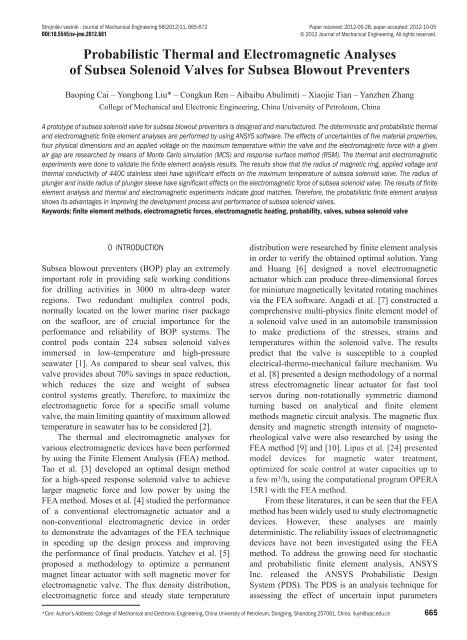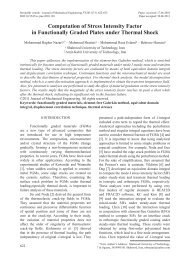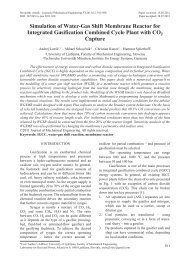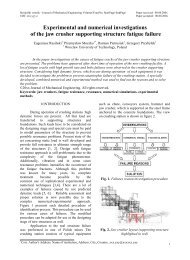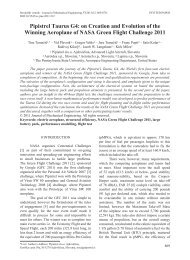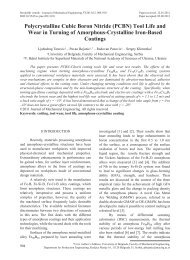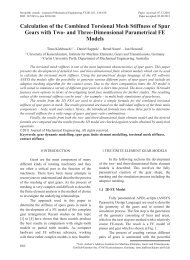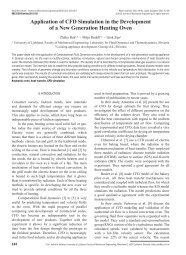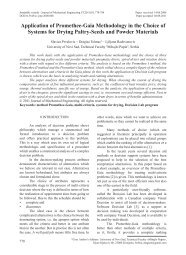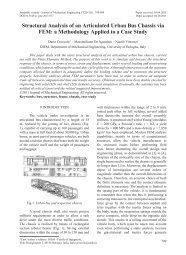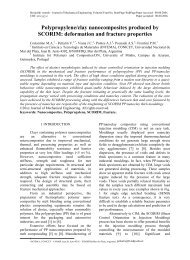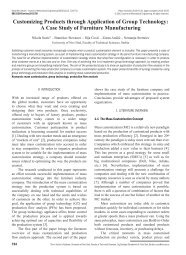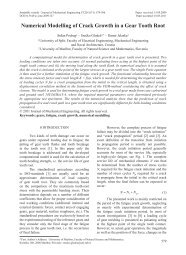Probabilistic Thermal and Electromagnetic Analyses of Subsea ...
Probabilistic Thermal and Electromagnetic Analyses of Subsea ...
Probabilistic Thermal and Electromagnetic Analyses of Subsea ...
You also want an ePaper? Increase the reach of your titles
YUMPU automatically turns print PDFs into web optimized ePapers that Google loves.
Strojniški vestnik - Journal <strong>of</strong> Mechanical Engineering 58(2012)11, 665-672Table 1. Statistical characteristic <strong>of</strong> material properties <strong>and</strong> dimensionsProperty Description Unit Mean COV Distributionk 316 <strong>Thermal</strong> conductivity <strong>of</strong> 316L stainless steel W/(mK) 15 0.06 Gaussk 440 <strong>Thermal</strong> conductivity <strong>of</strong> 440C stainless steel W/(mK) 24.2 0.06 Gaussk oil <strong>Thermal</strong> conductivity <strong>of</strong> conduction oil W/(mK) 0.111 0.02 Gaussh sea Convection heat transfer coefficient <strong>of</strong> seawater W/(m 2 K) 200 0.01 Gaussμ 440 Relative permeability <strong>of</strong> 440C stainless steel – 10000 0.05 GaussR pl Radius <strong>of</strong> plunger (see Fig. 2) m 0.0063 0.004 GaussR psi Inside radius <strong>of</strong> plunger sleeve (see Fig. 2) m 0.0065 0.003 GaussR pso Outside radius <strong>of</strong> plunger sleeve (see Fig. 2) m 0.0080 0.003 GaussR mr Radius <strong>of</strong> magnetic ring (see Fig. 2) m 0.0155 0.002 GaussU Applied voltage V 16 0.010 Gauss<strong>of</strong> variables are expressed as the product <strong>of</strong> meanvalves <strong>and</strong> Coefficient <strong>of</strong> Variations (COV).For both <strong>of</strong> the probabilistic thermal <strong>and</strong>electromagnetic analyses, the Latin HypercubeSampling was selected for MCS due to the fact thatthis technique avoids repeating samples that have beenevaluated, <strong>and</strong> also forces the tails <strong>of</strong> a distributionto participate in the sampling process. The centralcomposite design was used to locate the samplingpoints in the design space for RSM.2 EXPERIMENTSIn order to verify the finite element analysis results,the temperature within the subsea solenoid valve<strong>and</strong> electromagnetic force as a function <strong>of</strong> air gapwere measured. Four resistance thermometer sensors(ZYWRNK-191, ZhongYiHuaShi, China) were fixedin Point A, B, C <strong>and</strong> D when the coil was wound <strong>and</strong>the valve was installed, as shown in Fig. 2. The steadystate temperatures in the four points were measuredwhen the solenoid was energized by applied DCvoltage <strong>of</strong> 16 V in the constant temperature bath <strong>of</strong>10 °C.A static experiment was performed to measurethe relationship between the electromagnetic force<strong>and</strong> the air gap. The applied DC power was alsosupplied by a switching power supply (RXN-3020D),which is set to 16 V. The displacement <strong>of</strong> the plungerwas determined by an eddy current displacementsensor (JX70-04-B-M16*1-75-03K), <strong>and</strong> the forcewas measure by an S-shape force sensor (PST-20).By recoding the voltage outputs <strong>of</strong> the force sensor<strong>and</strong> eddy current sensor, the relationship between themagnetic force <strong>and</strong> the air gap could be calculated.a) b) c)Fig. 4. Distributions <strong>of</strong> a) temperature, b) magnetic flux line, <strong>and</strong> c) magnetic flux density668 Cai, B. – Liu, Y. – Ren, C. – Abulimiti, A. – Tian, X. – Zhang, Y.
Strojniški vestnik - Journal <strong>of</strong> Mechanical Engineering 58(2012)11, 665-672radius <strong>of</strong> plunger <strong>and</strong> inside radius <strong>of</strong> plunger sleevehave significant effects on the electromagnetic force<strong>of</strong> subsea solenoid valve. The two variables areresponsible for three quarters or more <strong>of</strong> the effecton failure probability, with the other four variablestogether making up for the remaining part. Therefore,more attention should be paid to the radius <strong>of</strong> theplunger <strong>and</strong> inside radius <strong>of</strong> plunger sleeve when thevalve is designed. The two variables are followed byapplied voltage, the radius <strong>of</strong> magnetic ring, relativepermeability <strong>of</strong> 440C stainless steel <strong>and</strong> outside radius<strong>of</strong> plunger sleeve (R pl > R psi > U > R mr > μ 440 > R pso ),whereas they are followed by radius <strong>of</strong> magneticring, applied voltage, outside radius <strong>of</strong> plunger sleeve<strong>and</strong> relative permeability <strong>of</strong> 440C stainless steel (R pl> R psi > R mr > U > R pso > μ 440 ). Similarly, the orders<strong>of</strong> sensitivity for some unimportant r<strong>and</strong>om inputvariables are different.solenoid valves for subsea blowout preventers areperformed by using ANSYS s<strong>of</strong>tware. The effects <strong>of</strong>uncertainties <strong>of</strong> five material properties, four physicaldimensions <strong>and</strong> an applied voltage on the maximumtemperature within the valve <strong>and</strong> the electromagneticforce with a given air gap are researched. A prototype<strong>of</strong> subsea solenoid valve was manufactured, <strong>and</strong> thethermal <strong>and</strong> electromagnetic experiments were doneto validate the finite element analysis results.(1) The radius <strong>of</strong> the magnetic ring, applied voltage<strong>and</strong> thermal conductivity <strong>of</strong> 440C stainlesssteel have significant effects on the maximumtemperature <strong>of</strong> subsea solenoid valve.(2) The radius <strong>of</strong> the plunger <strong>and</strong> inside radius <strong>of</strong>the plunger sleeve have significant effects on theelectromagnetic force <strong>of</strong> subsea solenoid valve.(3) RSM <strong>and</strong> MCS predict different orders <strong>of</strong>sensitivity for some r<strong>and</strong>om input variables onmaximum temperature <strong>and</strong> electromagnetic force;fortunately, they have small influences.(4) The results <strong>of</strong> the finite element analysis <strong>and</strong>thermal <strong>and</strong> electromagnetic experiments indicategood matches.(5) The probabilistic finite element analysismethod shows the advantages in acceleratingthe development process <strong>and</strong> improving theperformance <strong>of</strong> subsea solenoid valves.5 ACKNOWLEDGEMENTSThe authors wish to acknowledge the financialsupport <strong>of</strong> the National High-TechnologyResearch <strong>and</strong> Development Program <strong>of</strong> China(No. 2007AA09A101), National Natural ScienceFoundation <strong>of</strong> China (No. 50874115), Program forChangjiang Scholars <strong>and</strong> Innovative Research Teamin University (IRT1086), Taishan Scholar project<strong>of</strong> Sh<strong>and</strong>ong Province (TS20110823), Sh<strong>and</strong>ongProvince Science <strong>and</strong> Technology DevelopmentProject (2011GHY11520) <strong>and</strong> Incubation Programme<strong>of</strong> Excellent Doctoral Dissertation <strong>of</strong> China University<strong>of</strong> Petroleum (No. 2010–02).6 REFERENCESFig. 10. Sensitivity <strong>of</strong> electromagnetic force to r<strong>and</strong>om inputvariables; a) MCS, <strong>and</strong> b) RSM4 CONCLUSIONSThe deterministic <strong>and</strong> probabilistic thermal <strong>and</strong>electromagnetic finite element analyses <strong>of</strong> subsea[1] Shaughnessy, J.M., Armagost, W.K. (1999). Problems<strong>of</strong> ultra-deepwater drilling. Proceedings <strong>of</strong> the IADC/SPE Asia Pacific Drilling Technology Conference,APDT, Amsterdam, p. 179-–188.[2] Cai, B., Liu, Y., Tian, X., Wang, Z., Wang, F., Li, H., Ji,R. (2011). Optimization <strong>of</strong> submersible solenoid valvesfor subsea blowout preventers. IEEE Transactions onMagnetics, vol. 47, no. 2, p. 451-458, DOI:10.1109/TMAG.2010.2100825.<strong>Probabilistic</strong> <strong>Thermal</strong> <strong>and</strong> <strong>Electromagnetic</strong> <strong>Analyses</strong> <strong>of</strong> <strong>Subsea</strong> Solenoid Valves for <strong>Subsea</strong> Blowout Preventers671
Strojniški vestnik - Journal <strong>of</strong> Mechanical Engineering 58(2012)11, 665-672[3] Tao, G., Chen, H.Y., J, Y.Y., He, Z.B. (2002). Optimaldesign <strong>of</strong> the magnetic field <strong>of</strong> a high-speed responsesolenoid valve. Journal <strong>of</strong> Materials ProcessingTechnology, vol. 129, no. 1-3, p. 555-558, DOI:10.1016/S0924-0136(02)00633-7.[4] Moses, A., Al-Naemi, F., Hall, J. (2003). Designing<strong>and</strong> prototyping for production. Practical applications<strong>of</strong> electromagnetic modeling. Journal <strong>of</strong> Magnetism<strong>and</strong> Magnetic Materials, vol. 254-255, p. 228-233,DOI:10.1016/S0304-8853(02)00963-0.[5] Yatchev, I., Gueorgiev, V., Hinov, K. (2009).Optimization <strong>of</strong> an axisymmetric linear electromagneticvalve actuator. COMPEL: The International Journalfor Computation <strong>and</strong> Mathematics in Electrical <strong>and</strong>Electronic Engineering, vol. 28, no. 5, p. 1249-1256,DOI:10.1108/03321640910969494.[6] Yang, S.M., Huang, C.L. (2009). Design <strong>of</strong> a newelectromagnetic actuator which can produce threedimensionalforces. IEEE Transactions on Magnetics,vol. 45, no. 10, p. 4153-4156, DOI:10.1109/TMAG.2009.2022951.[7] Angadi, S.V., Jackson, R.L., Choe, S.Y., Flowers,G.T., Suhling, J.C., Chang, Y.K., Ham, J.K. (2009).Reliability <strong>and</strong> life study <strong>of</strong> hydraulic solenoidvalve. Part 1 A multi-physics finite element model.Engineering Failure Analysis, vol. 16, no. 3, p. 874-887, DOI:10.1016/j.engfailanal.2008.08.011.[8] Wu, D., Xie, X., Zhou, S. (2010). Design <strong>of</strong> a normalstress electromagnetic fast linear actuator. IEEETransactions on Magnetics, vol. 46, no. 4, p. 1007-1014, DOI:10.1109/TMAG.2009.2036606.[9] Li, W.H., Du, H., Guo, N.Q. (2003). Finiteelement analysis <strong>and</strong> simulation evaluation <strong>of</strong> amagnetorheological valve. International Journal <strong>of</strong>Advanced Manufacturing Technology, vol. 21, vol. 6,p. 438-445.[10] Salloom, M.Y., Samad, Z. (2011). Finite elementmodeling <strong>and</strong> simulation <strong>of</strong> proposed design magnetorheologicalvalve. International Journal <strong>of</strong> AdvancedManufacturing Technology, vol. 54, no. 5-8, p. 421-429, DOI:10.1007/s00170-010-2963-1.[11] Reh, S., Beley, J.D., Mukherjee, S., Khor, E.H.(2006). <strong>Probabilistic</strong> finite element analysis usingANSYS. Structural Safety, vol. 28, no. 1-4, p. 17-43,DOI:10.1016/j.strusafe.2005.03.010.[12] Liu, D., Lai, X., Ni, J., Peng, L., Lan, S., Lin, Z.(2007). Robust design <strong>of</strong> assembly parameters onmembrane electrode assembly pressure distribution.Journal <strong>of</strong> Power Sources, vol. 172, no. 2, p. 760-767,DOI:10.1016/j.jpowsour.2007.05.066.[13] Nakamura, T., Fujii, K. (2006). <strong>Probabilistic</strong> transientthermal analysis <strong>of</strong> an atmospheric reentry vehiclestructure. Aerospace Science <strong>and</strong> Technology, vol. 10,no. 4, p. 346-354, DOI:10.1016/j.ast.2006.02.002.[14] Zulkifli, M.N., Famal, Z.A.Z., Quadir, G.A.(2011). Temperature cycling analysis for ballgrid array package using finite element analysis.Microelectronics International, vol. 28, no. 4, p. 17-28, DOI:10.1108/13565361111097083.[15] Nemeth, N.N., Evans, L.J., Jadaan, O.M., Sharpe,W.N., Beheim, G.M., Trapp, M.A. (2007). Fabrication<strong>and</strong> probabilistic fracture strength prediction <strong>of</strong>high-aspect-ratio single crystal silicon carbidemicrospecimens with stress concentration. Thin SolidFilms, vol. 515, no. 6, p. 3283-3290, DOI:10.1016/j.tsf.2006.01.041.[16] Liu, P.F., Zheng, J.Y. (2010). Strength reliabilityanalysis <strong>of</strong> aluminium-carbon fiber/epoxy compositelaminates. Journal <strong>of</strong> Loss Prevention in the ProcessIndustries, vol. 23, no. 3, p. 421-427, DOI:10.1016/j.jlp.2010.02.002.[17] Cai, B., Liu, Y., Li, H., Liu, Z. (2011). Bucklinganalysis <strong>of</strong> composite long cylinders usingprobabilistic finite element method. Mechanika,vol. 17, no. 5, p. 467-473, DOI:10.5755/j01.mech.17.5.721.[18] Cai, B., Liu, Y., Liu, Z. Tian, X. Ji, R., Zhang, Y.(2012). <strong>Probabilistic</strong> analysis <strong>of</strong> composite pressurevessel for subsea blowout preventers. EngineeringFailure Analysis, vol. 19, p. 97-108, DOI:10.1016/j.engfailanal.2011.09.009.[19] Chung, M., Gweon, D. (2003). Optimal design <strong>and</strong>development <strong>of</strong> electromagnetic linear actuator formass flow controller. KSME International Journal,vol. 17, no. 1, p. 40-47.[20] Tsai, N., Chiang, C. (2010). Design <strong>and</strong> analysis<strong>of</strong> magnetically-drive actuator applied for linearcompressor. Mechatronics, vol. 20, no. 5, p. 596-603,DOI:10.1016/j.mechatronics.2010.06.001.[21] Cai, B., Liu, Y., Tian, X., Wang, F., Li, H., Ji, R.(2010). An experimental study <strong>of</strong> crevice corrosionbehaviour <strong>of</strong> 316L stainless steel in artificial seawater.Corrosion Science, vol. 52, no. 10, p. 3235-3242,DOI:10.1016/j.corsci.2010.05.040.[22] Tanaka, S., Ueda, K., Mitamura, N., Oohori, M.(2006). The development <strong>of</strong> an austenitic stainlesssteel bearing with high corrosion resistance. Journal<strong>of</strong> ASTM International, vol. 3, no. 9, JAI100424,DOI:10.1520/JAI100424.[23] Zheng, L., Neville, A., Gledhill, A., Johnston, D.(2009). An experimental study <strong>of</strong> the corrosionbehavior <strong>of</strong> nickel tungsten carbide in some waterglycolhydraulic fluids for subsea applications.Journal <strong>of</strong> Materials Engineering <strong>and</strong> Performance,vol. 19, no. 1, p. 90-98, DOI:10.1007/s11665-009-9416-8.[24] Lipus, L. C., Acko, B., Hamler, A. (2012). Magneticdevice simulation modelling <strong>and</strong> optimisation forscale control. International Journal <strong>of</strong> SimulationModelling, vol. 11, no. 3, p. 141-149, DOI:10.2507/IJSIMM11(3)3.205.672 Cai, B. – Liu, Y. – Ren, C. – Abulimiti, A. – Tian, X. – Zhang, Y.


